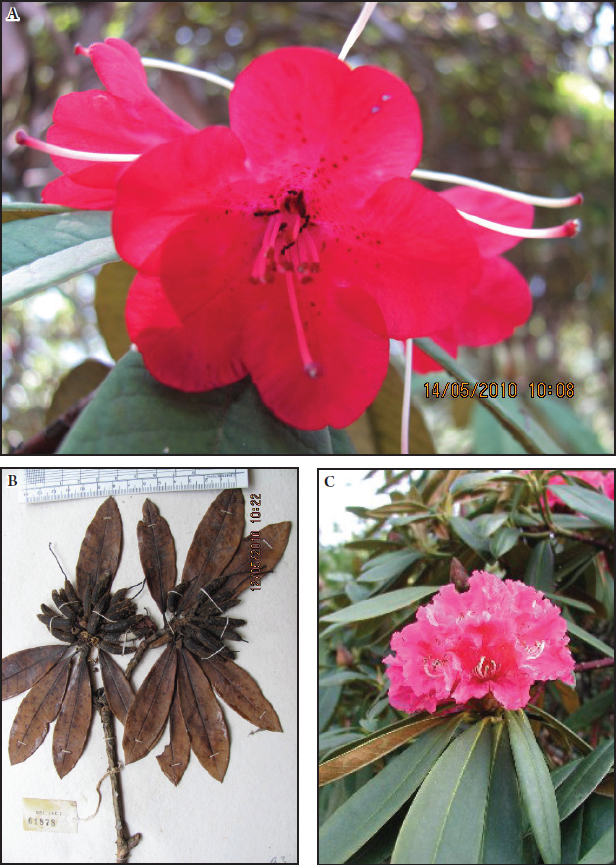Variation in Rhododendron arboreum Sm. complex (Ericaceae): insights from exomorphology, leaf anatomy and pollen morphology
Abstract
Rhododendron arboreum Sm., placed under the genus Rhododendron L. in the family Ericaceae Juss. consists of c. 1000 species, of these c. 102 species occur in India. R. arboreum Sm. is restricted to a few South Eastern Asian countries. In India, the species is distributed in the Himalayas, North Eastern India and hill tops of South Western Ghats. Detailed investigations of the genus were studied by several workers but nobody studied variation in R. arboreum complex. A few workers described pollen morphology of Ericaceae including Rhododendron, but they did not study different subspecies of R. arboreum. No detailed investigation on leaf anatomy was also reported. The purpose of the present study is to evaluate the contribution of leaf anatomy and pollen morphology along with herbarium and field based exomorphological data to delimit infraspecific variations in R. arboreum complex.
References
Bhattacharyya D., Sanjappa M. 2014. Rhododendron L. In: Sanjappa M., Sastry A.R.K. (eds), Fascicle of Flora of India. Fascicle 25. Ericaceae: 9, 87–93. Botanical Survey of India, Kolktata.
Carpenter K.J. 2005. Stomatal architecture and evolution in basal angiosperms. Am. J. Bot. 92 (10): 1595–1615.
Chamberlain D.F. 1982. A revision of Rhododendron II. Subgenus Hymenanthes. Notes Roy. Bot. Gard. Edinburgh 39 (2): 328–332.
Chamberlain D.F., Hyam R., Argent G., Fairweather G., Walter K.S. 1996. The genus Rhododendron: Its classification and synonymy: 1–184. Royal Botanic Garden Edinburgh.
Clarke C.B. 1882. Ericaceae. In: Hooker J.D. (ed.), Flora of British India 3: 465. Reeve & Co., London.
Cox H.T. 1948. Studies in the comparative anatomy of the Ericales II: Ericaceae – subfamily Arbutoideae. Am. Midl. Nat. 40 (2): 493–498.
Craven L.A., Goetsch L.A., Hall B.D., Brown G.K. 2008. Classification of the Vireya group of Rhododendron (Ericaceae). Blumea 53: 435–442.
Dilcher D.L. 1974. Approaches to the identification of angiosperm leaf remains. Bot. Rev. 40 (1): 1–53.
Erdtman G. 1952. Pollen morphology and plant taxonomy I. Angiosperms: 1–539. Almqvist & Wikshell, Stockholm.
Erdtman G. 1969. Handbook of palynology: 486. Munksgaard, Copenhagen.
Erdtman G. 1986. Pollen morphology and plant taxonomy: Angiosperms (an introduction to palynology): 553. E.J. Brill, Leiden.
Fahn A. 1997. Plant anatomy, 4th ed.: 168. Aditya Books (P) Ltd., New Delhi (India).
Hickey L.J. 1973. Classification of the architecture of dicotyledonous leaves. Am. J. Bot. 60 (1): 17–33.
Jayaweera D.M., Senaratna L.K. 2006. Medicinal plants (indigenous and exotic) used in Ceylon. Part 2: 185. The National Science Foundation, Colombo, Sri Lanka.
Kron K.A., Judd W.S., Stevens P.F., Crayn D.M., Anderberg A.A., Gadek P.A., Quinn C.J., Luteyn J.L. 2002. Phylogenetic classification of Ericaceae: Molecular and morphological evidence. Bot. Rev. 68 (3): 335–423.
Long D.G. 1991. Ericaceae. In: Grierson A.J.C., Long D.G. (eds), Flora of Bhutan 2 (1): 372. Royal Botanical Garden, Edinburgh.
Mabberley D.J. 2008. Rhododendron. Mabberley’s Plant-Book: A portable dictionary of plants, their classification and uses. Ed. 3: 737. Cambridge University Press, Cambridge, England.
Metcalfe C.R., Chalk L. 1950. Anatomy of Dicotyledonds. Vol. 1: 1–806. Clarendon Press, Oxford.
Mingyuan F., Ruizheng F., Mingyou H.E., Linzhen H.U., Hanbi Y., Chamber-Lain D.F. 2005. Rhododendron L. In: Ruizheng F., Chamberlain D.F. (eds), Flora of China. 14 (Ericaceae): 260–455. Science Press, Beijing & Missouri Botanical Garden Press, St. Louis.
Nair P.K.K., Kothari S. 1985. Pollen morphology of Indian Heteromerae. Adv. Pollen-Spore Res. 13: 1–7.
Niedenzu F. 1890. Über den anatomischen Bau der Laubblätter der Arbutoideae und Vaccinioideae in Beziehung zu ihrer systematischen Gruppierung und geographischen Verbreitung. Bot. Jahrb. 11: 134–263.
Oldfield F. 1959. The pollen morphology of some of the west European Ericales. Preliminary descriptions and a tentative key to their identification. Pollen Spores 1: 19–48.
Paria N.D., Pal A. 1990. Quantitative and experimental studies on pollen morphology of some Indian Rhododendron (Ericaceae). J. Palynol. 91: 95–104.
Park J., Song U. 2010. Pollen morphology of the genus Rhododendron (Ericaceae) in Korea. J. Corean For. Soc. 99 (5): 663–672.
Pradhan U.C., Lachungpa S.T. 1990. Sikkim-Himalayan rhododendrons: 65. Primulaceae Books, Kalimpong.
Sarwar A.K.M.G., Takahashi H. 2013. Pollen morphology of Rhododendron L. and related genera genera and its taxonomic significance. Bangladesh J. Pl. Taxon. 20 (2): 185–199.
Sarwar A.K.M.G., Ito T., Takahashi H. 2006. An overview of pollen morphology and its relevance to the sectional classification of Vaccinium L. (Ericaceae). Jpn. J. Palynol. 52 (2): 77–96.
Smith J.E. 1805. Rhododendron arboreum. In: Smith J.E. Exotic Botany. Vol. 1: 9. London.
Stace C.A. 1965. Cuticular studies as an aid to plant taxonomy. Bull. Brit. Mus. Bot. 4: 3–78.
Stace C.A. 1989. Plant taxonomy and biosystematics. 2nd ed: 78–80. Edward Arnold.
Stevens P.F. 1971. A classification of the Ericaceae: Subfamilies and tribes. Bot. J. Linn. Soc. 64: 1–53.
Vasanthy G., Pocock S.A.J. 1987. On the pollen tetrads of the South Indian Ericaceae, Gaultheria, Rhododendron & Vaccinium with special reference to R. nilagiricum Zenk. Bull. Jard. Bot. Nat. Belgium 57: 213–245.
Zhang Y.-J., Jin X.-F., Ding B.-Y., Zhu J.-P. 2009. Pollen morphology of Rhododendron subgen. Tsutsusi and its systematic implications. J. Syst. Evol. 47 (2): 123–138.


This work is licensed under a Creative Commons Attribution-NonCommercial-NoDerivatives 4.0 International License.
The journal is licensed by Creative Commons under BY-NC-ND license. You are welcome and free to share (copy and redistribute the material in any medium or format) all the published materials. You may not use the material for commercial purposes. You must give appropriate credit to all published materials.
The journal allow the author(s) to hold the copyrights and to retain publishing rights without any restrictions. This is also indicated at the bottom of each article.





